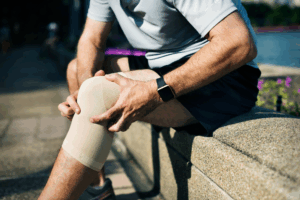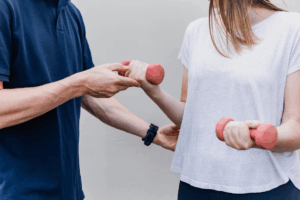Can Human Growth Hormone Accelerate Tendon and Ligament Recovery Therapy?
Tendon and ligament injuries are common in runners, lifters, and weekend athletes. The big question people ask is does HGH heal tendons and ligaments, and whether HGH for tendon repair has real support. Early research shows growth hormone (GH) can raise collagen production in connective tissue (the core material that gives tendons and ligaments strength) without directly boosting muscle protein the same way, which hints at a possible tissue-support role.
Still, human studies on real-world healing are mixed, and results vary by injury type and protocol. One trial in ACL surgery patients found HGH helped preserve knee strength, but it did not prove faster ligament healing. GH may support the environment for recovery, yet it isn’t a panacea. Rehab loading, rest, and nutrition remain the foundation; any hormone use should be supervised by a physician.

What Is HGH and How Does It Work in the Body?
Human growth hormone (HGH) is a peptide hormone made by the pituitary gland. It acts directly and through insulin-like growth factor-1 (IGF-1) to influence cell growth, metabolism, and tissue remodeling. In connective tissues, GH/IGF-1 signaling can stimulate fibroblasts (the cells that build collagen), helping maintain tendon structure.
HGH plays a vital role in childhood growth. It stimulates the growth of bones and tissues, helping children gain height and develop properly. Once growth plates in the bones (epiphyses) close after puberty, HGH no longer increases height, but it still remains essential. Even in adulthood, this hormone supports healthy metabolism, helps preserve muscle and bone structure, and assists in keeping blood sugar levels within a normal range.
Blocking GH reduces collagen synthesis in muscle–tendon units, while local GH delivery can raise tendon collagen production in research settings. These actions explain why it is discussed in the context of growth factors and tissue regeneration. However, clinical benefits for specific injuries are still uncertain and must be weighed against risks and medical guidance.
How HGH May Help with Tendon and Ligament Recovery?
When people look at HGH for tendon repair, they’re really asking about how sports injury recovery hormones work. GH can regulate collagen synthesis and support fibroblast activity, which may strengthen the matrix that tendons and ligaments rely on. Some studies report increased collagen turnover in human tendons after GH exposure and higher collagen production with local GH injections.
GH/IGF-1 pathways may also improve local blood flow and remodeling, which could matter in overuse states such as HGH for tendonitis discussions. That said, human outcome data are mixed: narrative reviews in rotator cuff repair note unclear or adverse effects, and benefits seen in lab or animal models do not always translate to faster or stronger healing in patients.
HGH for Tendonitis – Can It Speed Up Recovery?
Tendonitis is irritation of a tendon from overload or poor mechanics. People ask about HGH for tendonitis because HGH/IGF-1 signaling can increase collagen synthesis and repair cells. In theory, better matrix turnover and local blood flow can relieve strain on the tissue, which may ease swelling and pain over time. Still, tendonitis care starts with a combination of reloading, graded loading, form fixes, adequate sleep, and proper nutrition. If your clinician considers HGH injections, treat them as an add-on, not the main tool. Results vary by tendon and person, and they need to check labs, adjust plans, and watch for side effects regularly.
HGH for Tendon Repair After Injury
Partial tears and microtears need fresh collagen to bridge the gap. That is why people look at HGH tendon repair: more collagen made by fibroblasts could mean a denser, better-aligned matrix. A stronger matrix leads to a stronger tendon, and as a result, it lowers re-injury risk when loading resumes. Some lab and early clinical data support this pathway, but healing is complex, and timing matters. The best results come when hormone signals, progressive rehab, and protein intake work together. Use imaging and function tests to track progress, and step up loading only when pain, range of motion, and strength markers meet your thresholds.
HGH Dosage for Tendon Repair and Recovery
There is no universal HGH dosage for tendon repair. It needs to differ by age, sex, body weight, injury type, training load, and baseline IGF-1. That is why dosing should be individualized by a physician, with clear goals and close follow-up. A cautious medical approach usually includes:
- Baseline labs (IGF-1, fasting glucose, lipids), history, and exam.
- Low start, slow step-ups, tied to symptom change, and IGF-1 staying in the age-adjusted range.
- Defined trial window (e.g., 6–12 weeks), then stop or adjust based on function, not hype.
- Rehab first with loading progressions, eccentric and isometric work, technique fixes, sleep, protein, vitamin C with collagen, and creatine if appropriate.
Warning signs that call for dose cuts or discontinuation include edema, joint pain, numbness or tingling, headaches, worsened blood sugar, or rising IGF-1 above target. People with active cancer, uncontrolled diabetes, certain eye diseases, or severe sleep apnea may not be candidates. Athletes must also check anti-doping rules. HGH, if used, should be personalized, time-limited, and paired with a structured rehab plan, regular labs, and clear stop rules.

Combining HGH with Rehab and Nutrition
Even if HGH supports collagen growth, its effectiveness is maximized when combined with the basics – movement, nutrition, and rest. Physical therapy and controlled loading tell tendons how to remodel; HGH may simply help the process along. Nutrition matters just as much: enough protein (0.8 grams per kilogram of body weight per day), amino acids such as glycine and proline, and vitamin C before collagen-rich meals improve tendon synthesis. Sleep and stress control keep hormone levels balanced.
HGH alone won’t rebuild tissue, but when combined with structured rehab, nutrient-dense eating, and consistency, it can create a more favorable recovery environment for tendons and ligaments.
Does Science Support HGH Use for Tendon Healing Process?
So, does HGH heal tendons and ligaments? Research gives a mixed answer. Animal and cell studies show growth hormone and IGF-1 boost collagen formation and fibroblast activity – important for tendon strength. Some human studies found improved collagen turnover or muscle and tendon connection after surgery, but others saw no measurable speed-up in healing.
A 2020 review in Frontiers in Endocrinology noted that while GH promotes matrix remodeling in lab models, clinical trials are few and small. One randomized study in ACL reconstruction patients reported that HGH helped preserve muscle, but did not clearly shorten ligament recovery time. Another trial using local GH injections in rotator-cuff repair showed higher collagen gene expression, yet no consistent functional benefit.
Overall, science suggests HGH may support healing conditions, but it does not guarantee faster or stronger recovery. Most experts agree it should stay under research or prescription settings, not for self-use. HGH might aid collagen processes, but structured rehab and medical oversight remain the proven backbone of tendon and ligament repair.
Risks and Side Effects of HGH Use for Injury Recovery
While HGH can help tissue metabolism, it also carries risks. Common side effects include water retention, swollen joints, hand or foot tingling, and carpal tunnel–like symptoms. It may raise blood sugar and insulin resistance in some users. Long-term or high-dose use can enlarge soft tissues, thicken skin, or stress the heart. People with diabetes, tumors, or active cancers must avoid it. Unmonitored use can drive IGF-1 above safe limits, increasing potential health risks. Most side effects fade after stopping or reducing the dose, but regular blood checks and professional supervision are essential to keep treatment safe and effective.

How to Use HGH Safely for Tendon Repair
Safe HGH use starts with a medical consultation. A qualified physician should order baseline tests (IGF-1, glucose, liver, and kidney panels) to confirm if therapy is appropriate. Dosage must begin low, then increase slowly, checking labs every few weeks to keep IGF-1 within the age-adjusted range. Never copy another person’s HGH dosage for tendon repair or combine it with anabolic drugs.
During treatment, track changes in swelling, sleep, and energy. Stop or reduce the dose if you notice numbness, joint pain, or unusual fatigue. Combine HGH with balanced nutrition, structured rehab, and sufficient rest. Keep the therapy period defined (usually weeks, not years) and reassess need after the tendon regains function. Following these steps lowers risk and makes HGH a potential supportive, not standalone, part of recovery.
